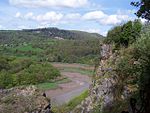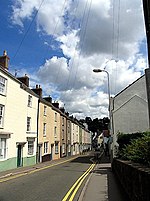Piercefield House is a largely ruined neo-classical country house near St Arvans, Monmouthshire, Wales, about 1.5 miles (2.4 km) north of the centre of Chepstow. The central block of the house was designed in the very late 18th century, by, or to the designs of, Sir John Soane. It is flanked by two pavilions, of slightly later date, by Joseph Bonomi the Elder. The house sits within Piercefield Park, a Grade I listed historic landscape, that was created in the 18th century as a notable Picturesque estate.
The estate has links to colonialism and slavery. After long ownership by the Walter family, in 1740 it was bought by Valentine Morris, a slaver and planter from Antigua. His son, also Valentine, developed the park and grounds into one of the 18th century’s most famous Picturesque landscapes. His prodigality ruined him, and the estate was sold to a banker, George Smith, who began the present house. He was in turn bankrupted and Piercefield was bought by Sir Mark Wood, a nabob who had made his fortune in Bengal. In 1802, the estate was bought by Nathaniel Wells, son of William Wells, a slaver from Saint Kitts, and Juggy, later Joardine Wells, his enslaved house servant. Nathaniel and his mother both received their freedom and he inherited the bulk of his father’s wealth. Establishing himself at Piercefield, Nathaniel Wells became, in turn, a Justice of the Peace, a Lieutenant in the Chepstow Yeomanry, and Deputy lieutenant and High Sheriff of Monmouthshire, a notable series of firsts, or near firsts, for a black man in Georgian England.
The house is now a shell, along with its extensive stable block, but its status as a Grade II* listed building reflects its importance. It is currently owned by the Reuben brothers, London-based property developers. A campaign to save and restore the building was launched by SAVE Britain's Heritage in 2013. The house has been repeatedly marketed for sale since the early 2000s but no sale has been concluded. Despite emergency stabilising work in 2008/9, the condition of the house continues to deteriorate.










